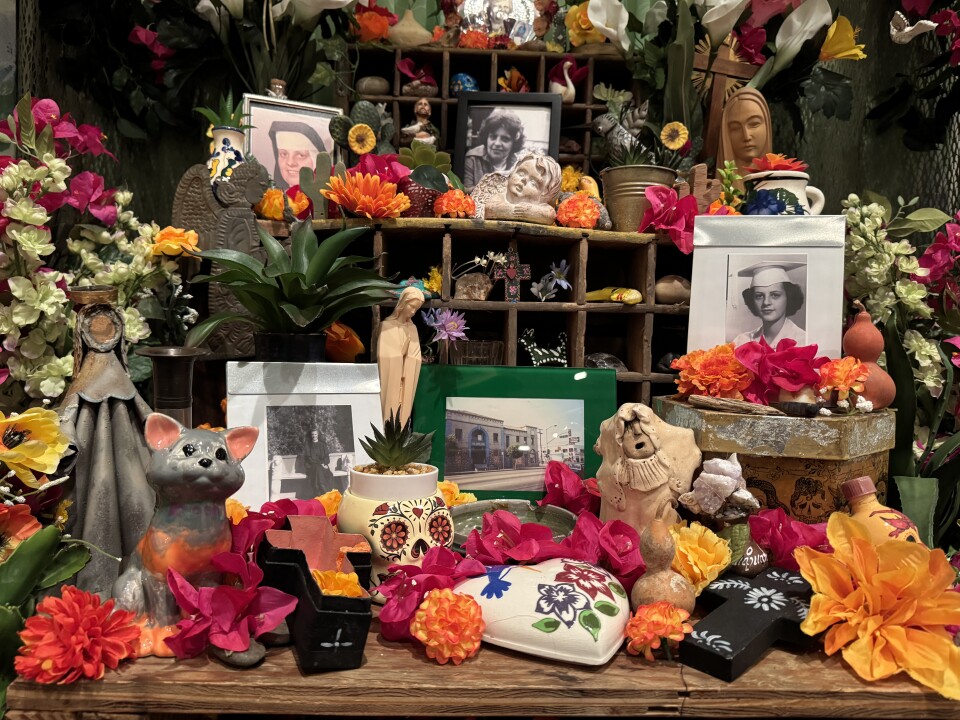Truth matters. Community matters. Your support makes both possible. LAist is one of the few places where news remains independent and free from political and corporate influence. Stand up for truth and for LAist. Make your year-end tax-deductible gift now.
At 93 years old, LA artist who helped popularize Day of the Dead gets her first solo show

The Mexican tradition of Day of the Dead, the holiday that honors loved ones who have passed, is by now internationally renowned.
The 2017 Pixar animated film Coco — inspired by the holiday — is available in nearly 50 languages. The calavera, a skull that’s a common symbol for Day of the Dead, can be found on all sorts of products including T-shirts and bags. But for most of the holiday’s history, it was not well-known outside of Mexico or the Mexican communities abroad that continued to celebrate it.
Day of the Dead started to emerge in popular culture in the 1970s during the Chicano movement and one artist who was critical in that transformation was Ofelia Esparza. Today, Esparza is 93 and on Oct. 18, the Vincent Price Art Museum in East L.A. will exhibit her first solo show "Ofelia Esparza: A Retrospective."
Esparza’s early life in East LA
Ofelia Esparza lived many lives before she became L.A.’s preeminent altarista. She was born in East L.A. in 1932, the first generation daughter of a family from Huanímaro, Guanajuato. Her family was so steeped in the traditions and customs of her parents’ home town that Esparza was often confused about where she actually lived.
“ I used to ask my mother, ‘Estamos en Mexico? Are we in Mexico?’” Esparza said.
Her mother, seeing that she liked to draw, encouraged her artistic inclinations,
“My mother started saving the meat wrappings — the butcher paper. She would cut out the edges and iron them," Esparza said. "So that was my paper.”
Every year her family created ofrendas — altars covered in marigolds, found objects and photos of loved ones who have passed to honor the dead — during Day of the Dead, as well as elaborate nacimientos, or nativity scenes during Christmas time. Esparza was surrounded by folk art and was encouraged to nurture her creativity but did not imagine a career in the arts.

She went on to have nine children with her husband Amado. After, she started a career as a teacher at City Terrace Elementary School.
“In my family, I was always the artist. In my class, I was the artist,” Esparza said, “But I think where [I was] really validated as an artist was at Self-Help Graphics.”
Sharing ofrendas from East LA to the world
Self-Help Graphics was a community art center in East L.A. co-founded in 1970 by a nun named Sister Karen Boccalero. When Sister Karen learned that Esparza grew up making altares at home with her family, she asked Esparza to help lead workshops and make ofrendas for the center's Day of the Dead celebrations. Through that work, Esparza started to be recognized as a master alterista.
“ [Self-Help Graphics] sent me to Glasgow, Scotland in 1996. [I] was in Chicago, at the Mexican Museum. It was just tapping into the community,” Esparza said.
Esparza would later be chosen as one of the consultants on the Pixar film Coco. The animators told her that the marigold bridge between the world of the living and the dead was inspired by how she spoke about the role of the ofrendas as a bridge.
Humbly, Esparza said that this link between our present and our past is something that she constantly encountered as she shared her ofrenda making practice abroad.
“ Our practices, our culture is very much similar all over the world,” Esparza said, “People — especially people native to their regions — have celebrated ancestors. We are linked, we are connected.”

What to expect at Esparza’s first solo show
“ To see it all there, it's beyond my wildest dreams,” Esparza said, with tears in her eyes, during the final days leading up to the opening of "Ofelia Esparza: A Retrospective" at the Vincent Price Art Museum.
The show will feature multiple ofrendas dedicated to people who’ve passed and made an impact on her life, including Sister Karen Boccalero and Esparza’s family members.
“ It's like a family reunion in a way. It's just the times and places I had never imagined I would revisit them all at the same time and it's wonderful,” Esparza said.
The show also features paintings of Esparza’s that have never been shown before and the recreation of a nacimiento, or nativity scene which was a ritual just as — if not more — important to Esparza’s family as the Day of the Dead ofrendas.
Esparza’s 64-year-old daughter Rosanna Esparza Ahrens was at the museum with her mom helping set up and she told me that she hopes the Latino community in L.A. feels embraced by this show.
“ We've been here and we belong here. During this time come to this space to see yourself reflected, and you could spend more than just a walk through a gallery, this is an experience,” Esparza Ahrens said.
Her mom, Ofelia Esparza, added, “This remembrance and this kind of work just connects us at a deeper level as human beings.”









